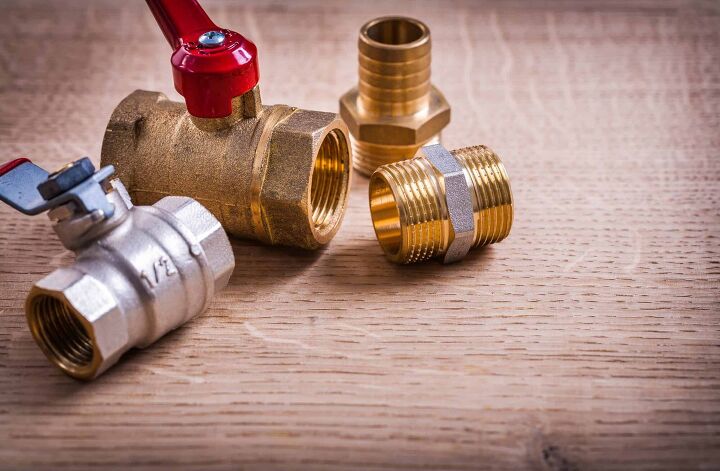How To Stop Brass Fittings From Leaking

Leaking fittings and pipes not only lead to the wastage of an essential natural resource, but they can also result in elevated utility bills and presents a hazard in the home.
In most cases, brass water supply shutoff valves use a brass compression fitting to be installed onto copper plumbing lines. This compression fitting involves a valve body, a round copper ring, or ferrule, and a nut that is attached to the body. The purpose of this nut is to compress the ferrule as it is constricted and seal the joint.
Wrap the brass fittings in Teflon tape and press them into the threading to stop them from leaking water. Apply pipe joint compound to the pipe fittings or the Teflon tape to prevent a leak. Inspect and tighten your compression nut if that is where the water leaks from your brass pipe fittings.
Do You Need to Hire a Plumber?
Get free, zero-commitment quotes from pro plubers near you.

How to Stop Brass Fittings from Leaking
Your first course of action when you have brass fittings that are leaking is to check the compression nut. This nut is responsible for keeping a water-resistant seal on the fitting and if it isn’t tight enough, leaks can transpire.
Tighten the compression nut and check if the flow of water out of the fitting has stopped. If it hasn’t, your next best option is to replace the ferrule. Tightening the nut compresses the ferrule inside. Over time, this copper ring can rust and prevent a sufficient closure.
- First, access and turn off your home’s water main. Drain water from the system by opening up all the lower level faucets in your home.
- Position a towel beneath the brass fitting to collect any water that could escape out as you’re disassembling it.
- With one pair of adjustable pliers, grip the valve body. At the same time, use another pair of pliers to unfasten the compression nut. Use special care not to bend or crook the copper tubing as you are applying pressure to the nut.
- Release the copper tubing out from the valve body. You’ll find the old ferrule still secured to the copper tubing.
- Use a pair of pliers to free the old ferrule from the copper tubing. To break the bond, you may need to rotate the ferrule back and forth. Once released, the nut should still linger on the tubing.
- Use a clean cloth to wipe off the end of the copper tubing. Rid the pipe of dust, rust, and any calcification.
- Slide the new ferrule into position on the copper tubing. Apply pipe joint compound onto both the end of the tubing and the ferrule. The compound will act as a lubricant and make it simpler for the ferrule to be compressed.
- Replace the copper tube in the valve body and push it in as far as it will go.
- By hand, screw the compression nut onto the valve body. Tighten the nut the same way you loosened it previously, using two sets of adjustable pliers. Place one pair on the valve body to hold it in place and another on the nut to tighten.
- Turn the water main valve back on and examine the joints for leaks. If you notice a few droplets of water, try tightening the nut more. If the leak persists, the entire copper pipe may be damaged. If this is the case, shut off the water and disassemble again. If possible, use a tube cutter to cut the pipe a few inches shorter and remove the damaged section. Then, reassemble with a fresh ferrule. Ferrules should never be recycled.
Quick Tip: Be careful not to over tighten the compression nut, as this is the most common cause of leaking in compression fittings.
Teflon Tape for Leaking Brass Fittings
If you have leaking in your brass fittings and the connection does not involve a compression fitting, it will benefit from some Teflon tape. Whereas, thread sealants are not always necessary for compression fittings since the compression of the ferrule between the nut and the pipe is what creates a seal.
Teflon tape, also referred to as “plumber’s tape,” is a thread seal tape that provides lubrication to permit a greater seating of the threads. Plumber’s tape is essential to ensure that the connections are properly sealed. Leaking in your brass fittings may be occurring because this type of sealant was never applied. Follow the below tips for successfully installing Teflon tape to prevent leaking:
- After you’ve dissembled the fittings, wrap the Teflon tape tightly around the male pipe and follow the direction the pipe’s threads will be screwed into the female pipe, most often clockwise.
- Complete 3-5 wraps around the pipe, shifting it as you go to ensure that all the threads are covered.
- Carefully press the tape into the threads and use your thumb to release any air bubbles.
- Stretch the tape taut and then tear to complete the wrap.
- Once applied, follow up by screwing the fittings back together.
Pipe Joint Compound for Leaking Brass Fittings
Connections that involve threaded fittings and pipes are susceptible to leaks if they are not properly sealed with either Teflon tape or pipe joint compound. You can apply the joint compound on its own but for best results, place the joint compound on top of the wrapped Teflon tape.
- Begin by unfastening the threaded fittings that are connected together.
- Clean off any old sealant or grime from both the male and female threads using a clean towel.
- Either apply the Teflon tape first, or simply put some beads of the pipe joint compound onto the male fitting’s threads.
- Screw the fittings back together and twist tightly to secure.
- Use a towel to wipe off any excess joint compound that may have collected on the outside of the joint.
- Allow ample drying time for the compound before you try running the water to test for leaks.
In most cases, applying a plumbing sealant for leaks is highly effective at stopping leaking water from coming out of your brass fittings.
Do You Need to Hire a Plumber?
Get free, zero-commitment quotes from pro plubers near you.

Related Questions
Can plumber’s putty stop a leak?
Using plumber’s putty instead of Teflon tape or pipe joint compound is a common mistake that homeowners make to stop leaking pipes. However, plumber’s putty can be used to prevent leaking, but only in specific areas. It is most often used to create a seal between a kitchen counter-top and a faucet. It can also be applied in tub drains, sink drains, and faucets but should not be used for pipes or fittings.
How tight should you tighten a compression fitting?
As previously stated, over tightening is the most common cause of leaking with compression fittings. Because of this, it’s widely understood to tighten while leaving one more thread to not distort the fitting and allow for flexibility if a leak should occur. After first hand-tightening, generally, you should only apply one full turn to the nut.

Jessica considers herself a home improvement and design enthusiast. She grew up surrounded by constant home improvement projects and owes most of what she knows to helping her dad renovate her childhood home. Being a Los Angeles resident, Jessica spends a lot of her time looking for her next DIY project and sharing her love for home design.
More by Jessica Stone












![The 10 Best Table Saws - [2022 Reviews & Buyer's Guide]](https://cdn-fastly.upgradedhome.com/media/2023/07/31/9070645/the-10-best-table-saws-2022-reviews-buyer-s-guide.jpg?size=350x220)
![The 5 Best Angle Grinders – [2022 Reviews & Buyer's Guide]](https://cdn-fastly.upgradedhome.com/media/2023/07/31/9071326/the-5-best-angle-grinders-2022-reviews-buyer-s-guide.jpg?size=350x220)
![How Much Weight Can a 4×4 Support Horizontally? [It Depends!]](https://cdn-fastly.upgradedhome.com/media/2023/07/31/9070333/how-much-weight-can-a-44-support-horizontally-it-depends.jpg?size=350x220)












